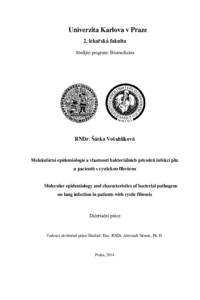Molekulární epidemiologie a vlastnosti bakteriálních původců infekcí plic u pacientů s cystickou fibrózou
Molecular epidemiology and characteristics of bacterial pathogens on lung infection in patients with cystic fibrosis
dizertační práce (OBHÁJENO)

Zobrazit/
Trvalý odkaz
http://hdl.handle.net/20.500.11956/67033Identifikátory
SIS: 153219
Kolekce
- Kvalifikační práce [1785]
Autor
Vedoucí práce
Oponent práce
Melter, Oto
Osička, Radim
Fakulta / součást
2. lékařská fakulta
Obor
Molekulární a buněčná biologie, genetika a virologie
Katedra / ústav / klinika
Mimofakultní pracoviště
Datum obhajoby
18. 9. 2014
Nakladatel
Univerzita Karlova, 2. lékařská fakultaJazyk
Čeština
Známka
Prospěl/a
Cystická fibróza (CF) je nejčastější autozomálně recesivně dědičné onemocnění v kavkazské populaci. Toto onemocnění je způsobeno poruchou proteinového kanálu, který zajišťuje přenos chloridových iontů skrz cytoplazmatickou membránu. Přestože tato porucha zasahuje různé orgány, je postižení dýchacího systému tím nejzávažnějším. Porušením iontové rovnováhy dochází v dýchacích cestách k tvorbě hustého a vazkého hlenu, který brání odstraňování prachových částic a bakterií. Hlavní komplikací CF jsou bakteriální infekce respiračního traktu, které přecházejí do chronicity a jsou nejčastější příčinou progresivního respiračního selhání a předčasného úmrtí. Nejvýznamnějšími původci těchto infekcí jsou Pseudomonas aeruginosa a bakterie komplexu Burkholderia cepacia (Bcc). Chronické infekce způsobené těmito mikroorganismy jsou prakticky nevyléčitelné. Situaci u infekcí způsobených těmito bakteriemi komplikuje výskyt epidemických kmenů, jež se přenáší mezi pacienty. Prevence šíření infekcí u pacientů s CF závisí na přesné a včasné bakteriologické diagnostice původce na druhové a kmenové úrovni a na důsledné aplikaci protiepidemických opatření, která jsou založena především na izolaci pacientů podle jejich mikrobiologického nálezu. Cílem této dizertační práce bylo definovat epidemiologii infekcí způsobených P....
Cystic fibrosis is the most abundant inherited autosomal recessive disease in Caucasian population. Cystic fibrosis is caused by a dysfunction of a transport channel which is responsible for the transport of chloride ions on the apical side of the plasma membrane. Despite the fact that the dysfunction of the transport channel is present in several organs, the most severely affected one is the respiratory system. Because of the ion imbalance, thick sticky mucus is produced on the surface of the airways which then prevents the removal of dust particles and bacteria. The main complications of cystic fibrosis are the bacterial infections of the respiratory system which become chronic during the patient's life and thus are the most common causes of the respiratory failure and premature death. The most important agents causing these infections are Pseudomonas aeruginosa and Burkholderia cepacia (Bcc). Infections caused by those bacteria are practically untreatable and serious complications arise from the existence of epidemic strains which can be transfered from patient to patient. Precise and fast diagnostics of pathogenic strains is a critical step to avoid spreading bacterial infections as well as strictly followed anti-epidemic strategies mainly based on isolation of cystic fibrosis patients...
